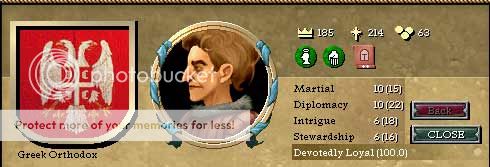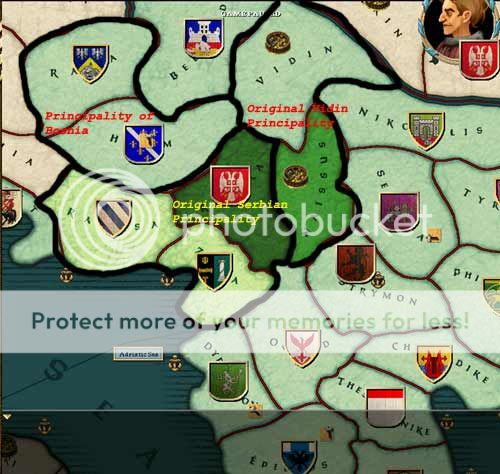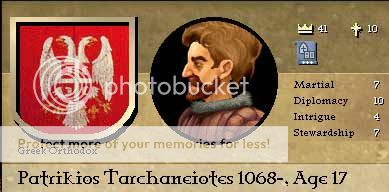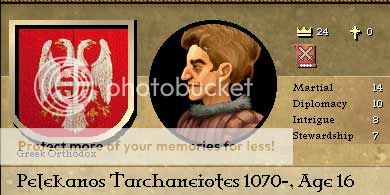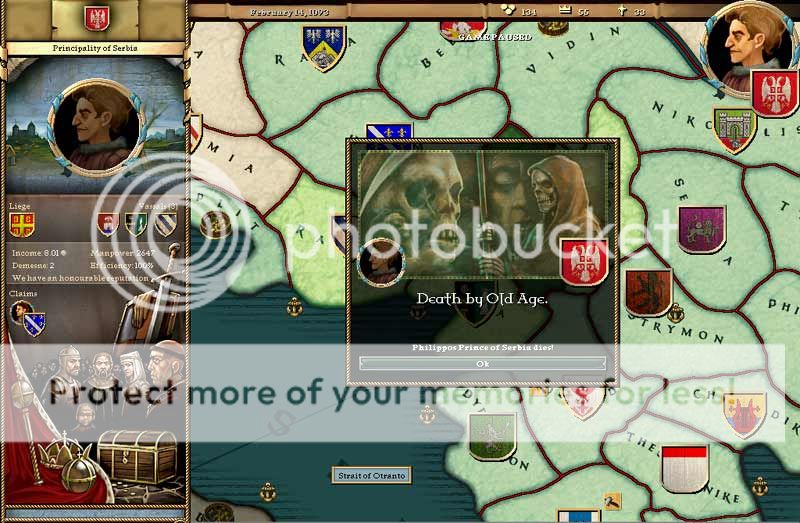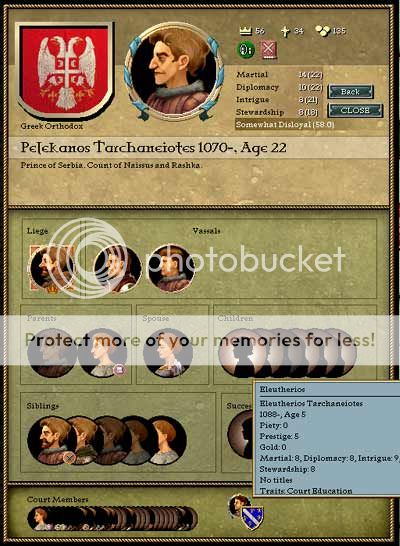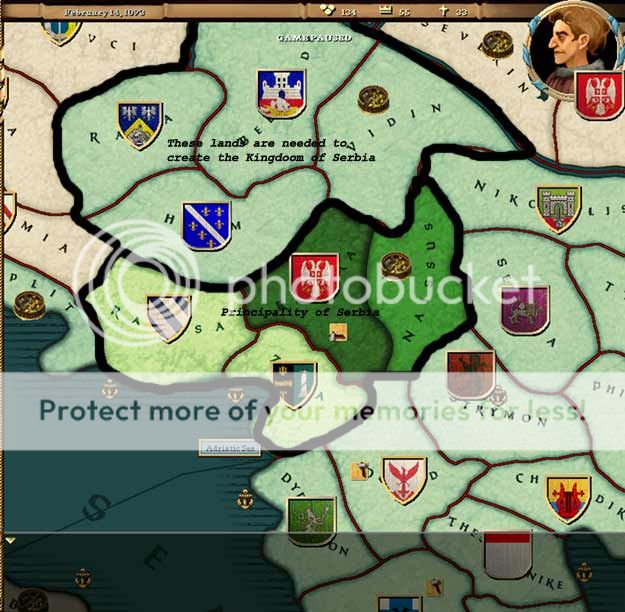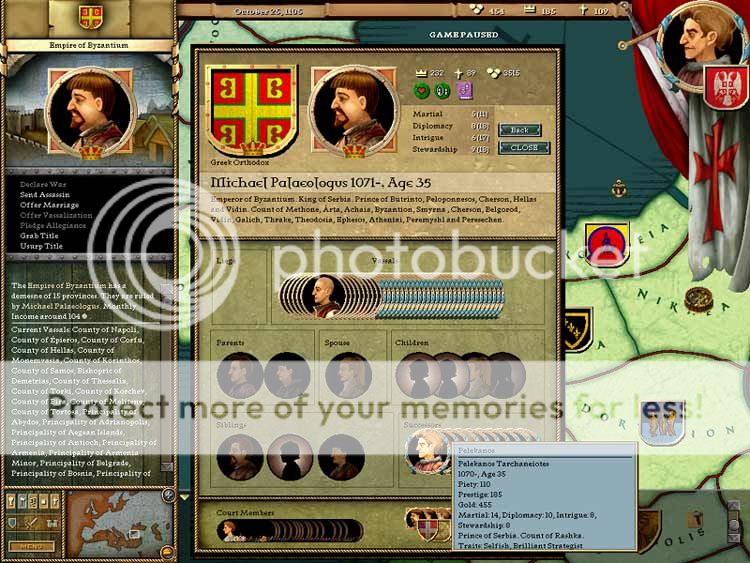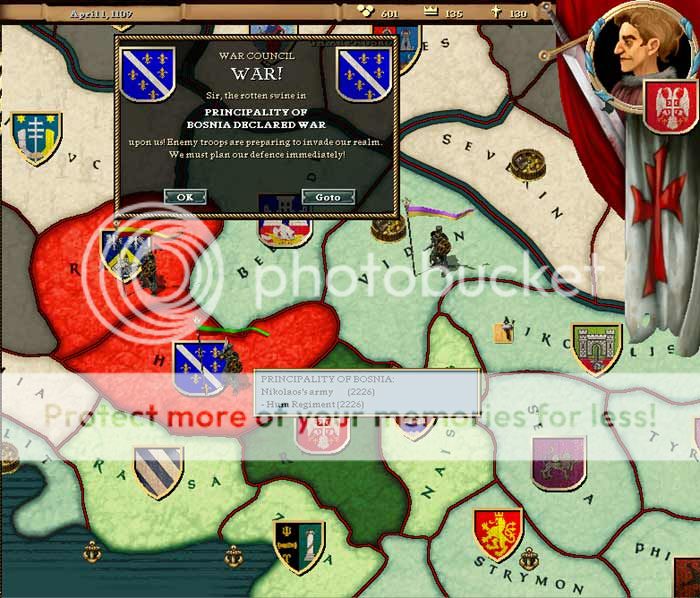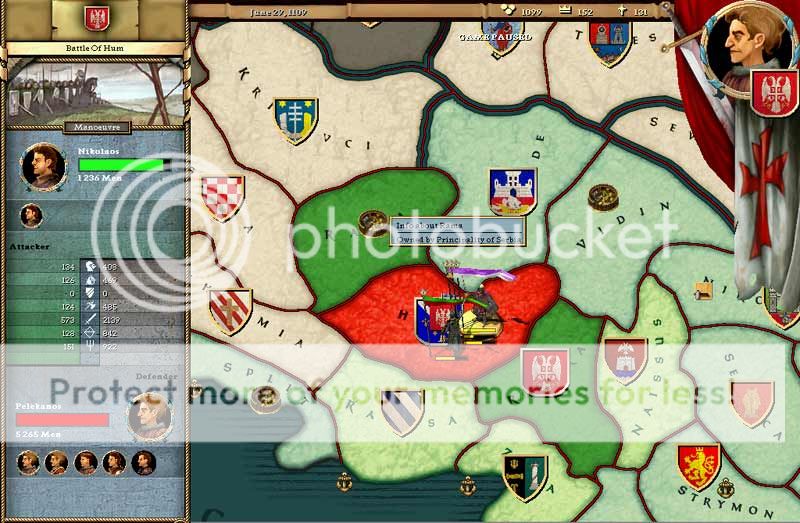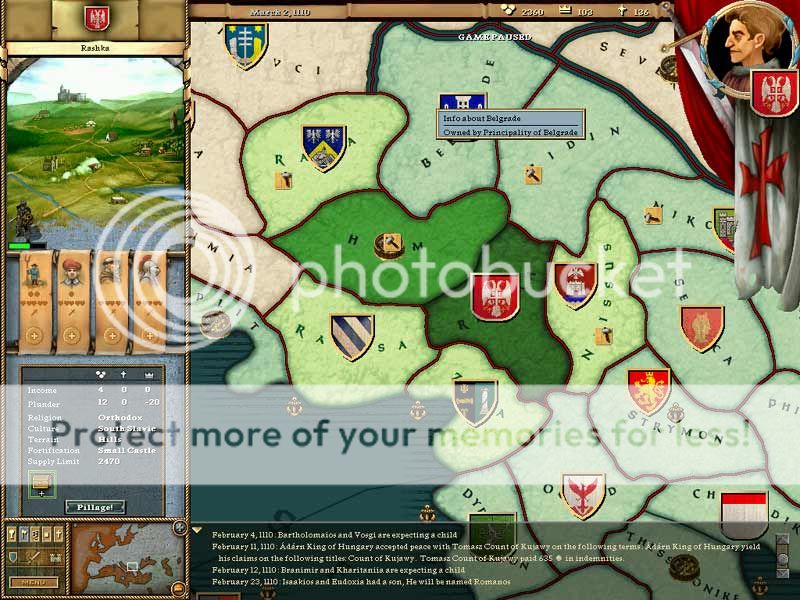Part III
Pelekanos Tarchaneiotes assumed control of the Principality of Serbia when his father, Prince Philippos Tarchaneiotes, died on February 14, 1093. Pelekanos declared a time of mourning in the Principality in respect to his father and did not officially accept the title of Prince of Serbia for some time. On June 4, 1093, Pelekanos officially accepted the titles of Prince of Serbia, Count of Rashka, and Count of Naissus. A great celebration was held on this momentous occasion which also marked the completion of a small castle in the Serbian capital at Rashka.
Prince Pelekanos and Family on the Eve of his acceptance of Titles
At the time of his father's death, Prince Pelekanos had already started a large family. He had two sons, Eleutherios age five, and Ioannes age five who was a bastard. Prince Pelekanos had three daughters, Zoe age five, Sofia age four, and Arete age two. Prince Pelekanos' wife, Sofia, had become rather stressed and upset over her husband's debauchery with other women which was a well known fact in the Principality.
The lands of the Principality of Serbia had not changed much since the war with the Prince of Vidin, however, Prince Pelekanos had big plans for his Principality.
The Principality of Serbia in 1093
Since Prince Pelekanos was a fresh nobleman among his peers, it would take some time before he could realize any of his big dreams for Serbia. He set about the education of his family and continued the work that his father had been occupied with prior to his death in respect to building better infrastructure in the provinces of Serbia.
On September 6, 1094, Prince Pelekanos sired another bastard son named, Michael. His wife, Sofia, was pregnant at the time and a few days later on September 28, 1094, she gave birth to a daughter named Helena. Sofia was so distraught with her husband over the matter that she became very ill shortly after her daughter was born was unable to recover.
Prince Pelekanos realized the error of his ways, and spent the next few years tending to the needs of his frail and sickly wife. He sent his agents out to insure that building projects were completed to his liking while he stayed in the castle in Rashka never leaving the side of his wife.
During this time many improvements were completed in Prince Pelekanos' demense. In Rashka an extensive road network was constructed, and a church built during Sofia's illness; while in Naissus a road network, tile factory, and a sawmill were all built. These improvements augmented the treasury of the Principality, and Prince Pelekanos began to save money for his future plans.
On October 8, 1100, Sofia Segouropoulos, wife of Prince Pelekanos, died in a state of high fever and in high dillusion. Prince Pelekanos was deeply grieved and stayed locked in his suites for days. He swore that as long as he lived he would never enjoy the company of another woman. He remained in a state of depression until the Pope sent out a call to arms on January 1, 1101, and Prince Pelekanos turned his attention back to his Principality.
As Prince Pelekanos' children came of age, his nobles began to fear that their fiefs would be revoked in order to insure that Prince Pelekanos' children would have land. On November 11, 1102, Prince Pelekanos issued an edict to his nobleman declaring their titles and lands would remain in their hands as long as they served their liege. The noblemen were overjoyed by this edict and Prince Pelekanos gained much prestige for his actions.
The concession to the noblemen still left Prince Pelekanos a problem of finding apropriate titles for his only legitimate son, Eleutherios. On February 26, 1104, Prince Pelekanos arranged a marriage between his son, Eleutherios, and Arete Machoneos, daughter of the Prince of Ikonion. A few months after the wedding on June 1, 1104, Prince Pelekanos gave Eleutherios the title of Count of Naissus, and proclaimed him the inheritor of the titles of the Prince of Serbia, and Count of Rashka.
On January 1, 1106, a secret rider arrived at the castle in Rashka. The rider carried a confidential letter with the seal of the Emperor of Byzantium and was addressed to Prince Pelekanos. The letter stated that Prince Pelekanos was to be the inheritor of the titles held by the Emperor of Byzantium should he die.
Prince Pelekanos is the heir to the Emperor of Byzantium!
Rather than being happy with the secret letter, Prince Pelekanos was fearful and angry. He did not want to become the Emperor of Byzantium, he wished to be the King of Serbia and have nothing to do with Constantinople. He decided it was time to began to try to accomplish his goals before he could be trapped behind the walls of Constantinople.
On May 13, 1106, Prince Pelekanos announced that because of his brother's marriage to the daughter of the Count of Ramas, he now had a claim on the title of Count of Ramas. Prince Pelekanos had inherited his father's claim on the Count of Hum, and now he was nearly ready to take on the Principality of Bosnia.
Before he could begin a war with any of his neighbors, Prince Pelekanos decided he needed to become more friendly with the King of Croatia. On March 5, 1107, Prince Pelekanos arranged a marriage between his daughter, Sofia, and Dmitar Trpimirovic, son of the King of Croatia and heir to the throne. To celebrate the friendly relations, Prince Pelekanos sponsored a royal feast at great expense with the Croat Royal family as his guests on December 11, 1108. Unfortunately, his recently married daughter died on January 9, 1109, as a result of eating too much rich food at the feast a month earlier. Prince Pelekanos was very grieved by the loss of his daughter, but realized the gravity of the political situation. Prince Pelekanos quickly arranged for Dmitar to marry his other daughter, Arete, and the ceremony was concluded on February 1, 1109.
With his daughter married to the crown prince of Croatia, and claims on the counties of the Principality of Bosnia, it was time for Prince Pelekanos to make a decision. Should he act now, or wait for a more opportune moment?



